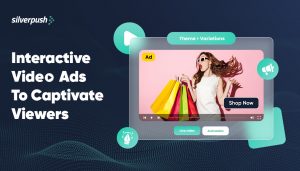Good things DO NOT come to those who wait
PUBLISH DATE: 18 January 2024
In the fast-paced world of advertising, the saying “Good things come to those who wait” couldn’t be further from the truth. In an era where technology evolves rapidly, and consumer behavior constantly shifts, advertisers clinging to outdated and monotonous campaign strategies may find themselves drifting away from valuable business opportunities.
Discover the Trends Taking Over in 2024
As we step into 2024, it becomes imperative for advertisers to discern and leverage key trends to maintain a competitive edge in this dynamic arena.
Brace yourself for the cookie countdown
The global digital advertising market was valued at $601.8 billion in 2023, with media ads accounting for 67.1% of overall expenditure. Clearly, digital advertising is a lucrative industry, and it’s no surprise that more companies are finding ways to capitalize on this trend. However, as more companies seek to tap into this thriving trend, it’s essential to address the impending challenge of cookie deprecation and its potential impact on advertisers and digital advertising revenue.
Google has outlined its plan to phase out third-party cookies entirely by the conclusion of 2024, and efforts are already underway to implement this transition. The initial measure involves the introduction of Privacy Sandbox Tracking Protection, which will be experienced by 1% of Chrome users globally. This feature aims to restrict cross-site tracking by default.
Focus will be more on Personalization and Hyper-Targeting
“One-size-fits-all” approach won’t be effective anymore. With abundance of information and choices consumers today expect to be catered with relevant ads, they want brands to directly speak to them based on their interests, needs and preferences.
70% of consumers expect personalization and 56% agreed that personalized experience motivates them to become a repeat customer. (Source)
From a business point of view, personalisation helped 77% of businesses increase their market share. This form of marketing has increased conversions nearly 50% for brands. (Source)
Brands that don’t invest in understanding their audience and delivering tailored content are at the risk of losing customer engagement.
Video Content Dominance
Video content will continue to dominate the existing ad formats, as billions of viewers tune in. According to stats, 2023 had seen a 23% surge in internet traffic volume globally, escalating usage of streaming videos. (source)
But, advertisers need to be mindful of the video length, as consumer attention span and patience is getting shorter. More than 25% of adults close a video after 10 seconds and approximately 50% of the viewers close it after 20 seconds. (source)
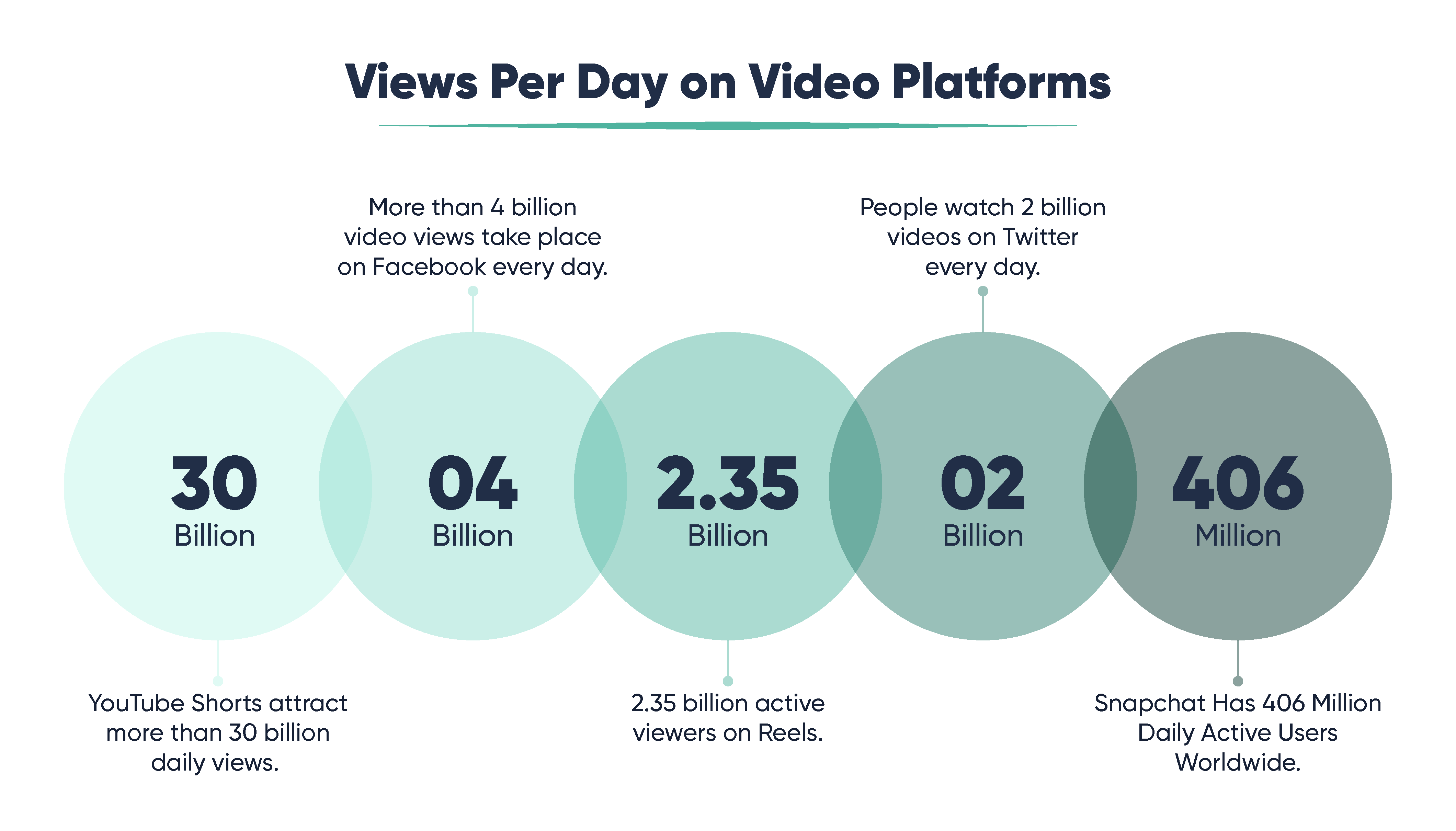
Brands should focus on creating high-quality and engaging video content for platforms like YouTube, TikTok, and Instagram. This trend is especially important as attention spans decrease, and visual storytelling becomes more critical.
Interactive Content
Since video content is gaining popularity advertisers need to advance their video advertising strategies. From the traditional video ads there is going to be an upgrade to dynamic interactive video ads.
To drive more engagement and conversion, advertisers should incline towards dynamic video ads as a result they have noted significant growth in their online sales.
Interactive content, such as polls, quizzes, and augmented reality experiences, not only captures attention but also provides a more immersive brand experience.
Among the interactive elements, shoppable TV ads have proven to be highly effective for cutting through the noise and boosting customer engagement due to their interactive nature. According to a survey, Shoppable ads have 55% ad recall and 50% interacting rate.
Role of Generative AI
Generative AI can process large amounts of data and generate valuable insights that can inform strategic decisions in campaign planning. Additionally, AI algorithms can analyze diverse datasets to identify and create new audience segments. Using these insights, advertisers can tailor their campaigns to specific demographics, ensuring more targeted and effective advertising.
Advertisers are using predictive analytics to analyze historical data and gain insights into user behavior, enabling them to optimize their campaigns further.
Conclusion
The advertising industry heavily relies on AI for campaign planning, execution, and optimization. Generative AI is changing the game by actively participating in the process. To achieve maximum success, brands should stay up-to-date with the latest trends in advertising and incorporate generative AI into their campaigns. This will provide advertisers with unparalleled levels of data analysis, audience segmentation, and dynamic content creation, leading to more efficient and personalized targeted advertising that can significantly boost the impact of campaigns. In a constantly evolving landscape, innovation is crucial to maintain growth and market dominance. Brands that embrace the potential of generative AI and adapt their strategies accordingly can exceed the expectations of the ever-changing consumer base. This will ensure a prosperous future in the dynamic world of advertising.
How to Create Relevant Contextual Ads with Mirrors Generative AI
PUBLISH DATE: 15 June 2023
Let’s face the truth: THIRD-PARTY COOKIES ARE LONG GONE!
Advertisers need to drastically shift from conventional targeting methods (requiring audience data) to privacy-focused strategies without compromising on delivering relevant ads.
Traditional targeting methods relied on cookies to reach targeted audiences by building a detailed profile of their online activity.
Growing data privacy concerns and the implementation of regulations like CCPA and GDPR raise the dilemma – how to balance between delivering personalized and relevant ads while respecting user privacy?
Enters Mirrors Generative AI, the next-gen contextual planning tool capable of discovering audiences without cookies and reaching them precisely in contextually relevant moments. The highly advanced tool was recently launched by Silverpush at its Cannes Lions 2023 debut.
Amplifying Relevance and Reach with Generative AI-Powered Contextual Advertising
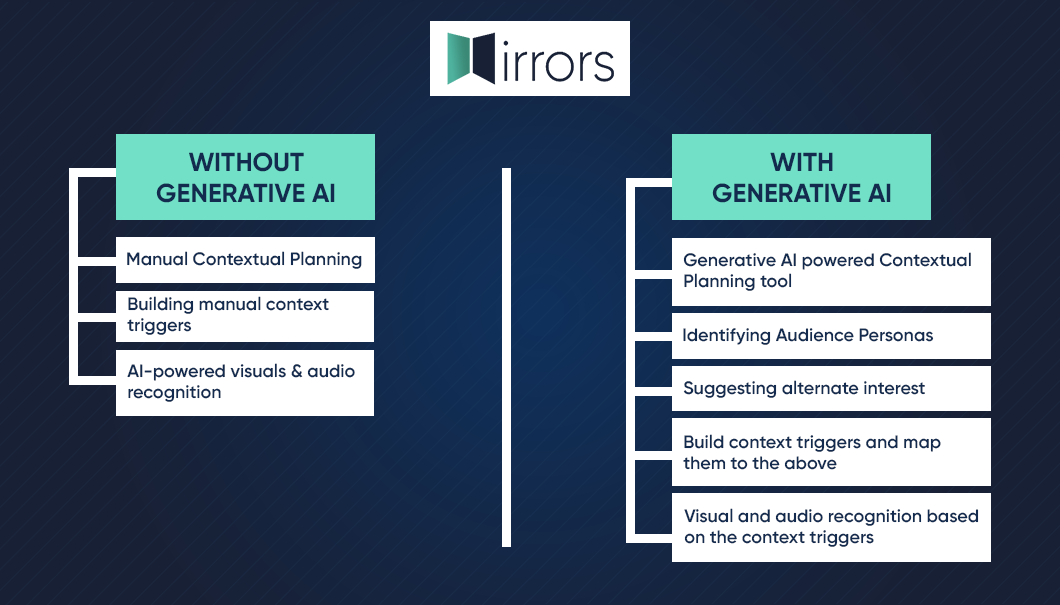
Mirrors, the flagship product of Silverpush, has recently integrated Generative AI into its contextual advertising technology to help brands reconnect with their untapped audiences.
It is a revolution that will boost the ever-present contextual intelligence by discovering newer audience personas without any human bias, guesswork, or stereotypes of the past.
By leveraging its predictive AI technology, Mirrors goes beyond the basics and delves deep into the content consumption habits of the target audience.
Utilizing advanced generative AI technology, Mirrors carefully analyzes videos and identifies key contexts in webpages, surveys, and a wide range of content on the open web, examining each word with precision.
This enables Mirrors to uncover patterns, decipher meaning, and extract valuable insights that surpass surface-level understanding.
Challenges Faced by Advertisers in Finding Contexts Manually
To maximize engagement, advertisers aim to target diverse audience personas based on their specific interests, timing, and context. However, relying on manual context-building methods has certain limitations.
1. Scale and Complexity: Manually creating context triggers for a large volume of content can be a time-consuming and complex task. Advertisers may struggle to keep up with the constantly evolving content landscape and the need to identify and update relevant triggers across various platforms and channels.
2. Subjectivity and Bias: Manual context trigger creation involves human judgment, which can introduce subjectivity and bias. Advertisers may have different interpretations of content, resulting in inconsistent or inaccurate context triggers that may not align with the intended audience or message.
3. Limited Contextual Understanding: Fully comprehending the context of every piece of content manually can be challenging. Advertisers may miss subtle nuances, references, or trends that could impact the appropriateness of ad placement.
4. Resource Intensity: Creating and managing manual context triggers requires dedicated resources, including skilled personnel, time, and effort. Advertisers may face limitations in terms of available resources, hindering their ability to effectively build and maintain comprehensive sets of context triggers.
5. Timeliness and Real-time Updates: Content evolves rapidly, and new trends and topics emerge regularly. Advertisers may struggle to keep their manual context triggers up to date, leading to potential misalignment between ads and current content relevance.
6. Scalability and Adaptability: As advertising campaigns scale and expand across different platforms and channels, managing manual context triggers becomes more challenging. Advertisers may find it difficult to adapt their triggers to new formats, channels, or emerging content types.
Eliminating Human Bias and Automating Context Discovery
The real power of Mirrors Generative AI lies in its ability to seamlessly integrate AI as a co-pilot to human intelligence. The advanced technology builds a comprehensive context list, well aligned with the audience’s personas and their direct and alternate interests. This enables advertisers to reach untapped/overlooked yet relevant audiences, resulting in enhancing incremental reach.
Why Plan Your Next Campaign With Mirrors Generative AI?
1. Cookieless Audience Discovery: The contextual planning tool will enable advertisers to identify contextually relevant audiences without relying on third-party cookies.
2. Scale without Compromise: Better contextual relevance leads to improved audience understanding, which can often be overlooked. By tapping into these overlooked audiences, advertisers can enhance their reach and engagement.
3. Understand Multicultural Audience: Mirrors Generative AI uses diverse datasets to assess performance across races and cultures. Then, analyzing metrics and understanding the emotional impact, bias, inclusion, and purchasing intent. This generates audience personas and passion points, offering advertisers valuable insights for informed decision-making.
4. Create Highly Customized Campaigns: Utilizing Mirrors Generative AI offers the opportunity to go beyond pre-defined taxonomies and gain unparalleled flexibility in creating highly customized campaigns.
Ready to Experience 3X Audience Expansion with Mirrors Generative AI?
It’s your time to broaden your audience reach with Mirrors Generative. To know how our advanced tool can boost your ROI fill and widen your reach with precision out the form on the right.
Silverpush Paves the Way in Revolutionizing Contextual Advertising with Generative AI Technology
PUBLISH DATE: 18 April 2023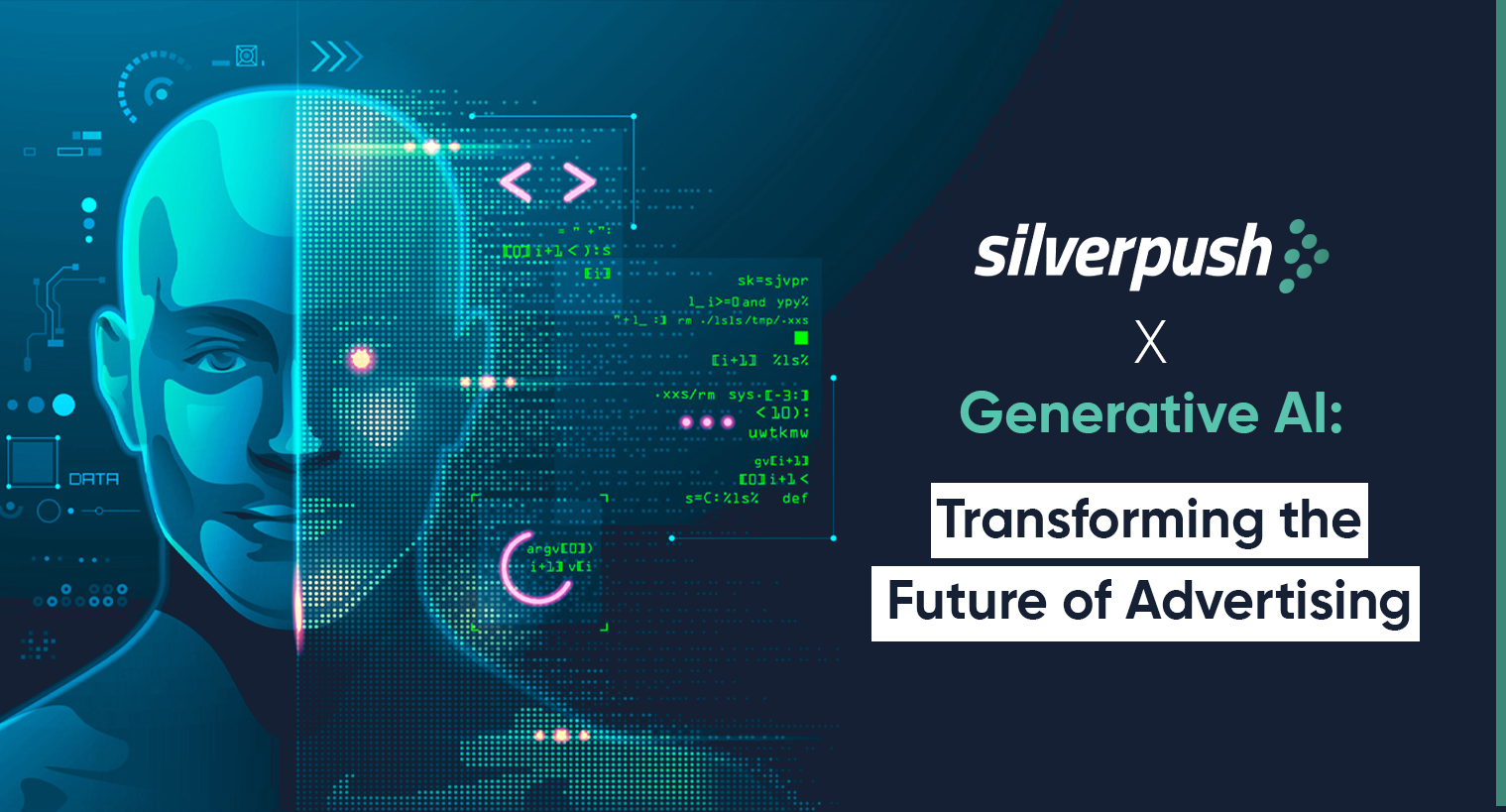
With the digital advertising industry rapidly evolving, it’s important to keep up with the latest trends and technologies.
Contextual advertising, which has been a game-changer for brands to maximize their ROI, has helped them reach their target audience in a more relevant and personalized way.
But, with the advent of newer technologies, even this life savior of brands after the apocalypse of third-party cookies requires an upgrade.
Generative AI, which has taken the world by storm has revolutionized work and creativity, offering numerous benefits and opportunities.
While many industries have already incorporated Generative AI into their business, contextual advertising is close and is also exploring how this technology can benefit them.
How will Generative AI Pave the Way for Contextual Advertising?
Generative AI is a powerful technology that has the potential to transform the way advertisers reach their target audiences.
Unlike traditional AI models, which rely on historical data, Generative AI can create new and unique data sets, enabling advertisers to expand their reach to audiences that were previously out of reach using traditional methods.
This technology can identify patterns and correlations between seemingly unrelated data points, resulting in a more personalized and relevant advertising experience for users.
With the ability to generate new data sets and identify new audience segments, Generative AI is opening up new possibilities for advertisers to reach their target audiences with greater accuracy and efficiency.
Silverpush X Generative AI: Changing the Advertising Game for Brands
In an age where privacy concerns are at an all-time high, relying on third-party cookies to reach relevant audiences has become increasingly challenging.
Silverpush, which is a hyper-contextual advertising company has incorporated Generative AI into its contextual AI platform- Mirrors to provide brands with an effective solution to target without the use of cookies.
The launch of a contextual planning tool powered by Generative AI represents a significant advancement in the capabilities of Silverpush’s flagship product, Mirrors.
By incorporating next-generation AI capabilities, the tool further enhances Mirrors’ contextual offering, addressing the challenges of cookieless targeting and revolutionizing the digital advertising space.
How will it Benefit Advertisers?
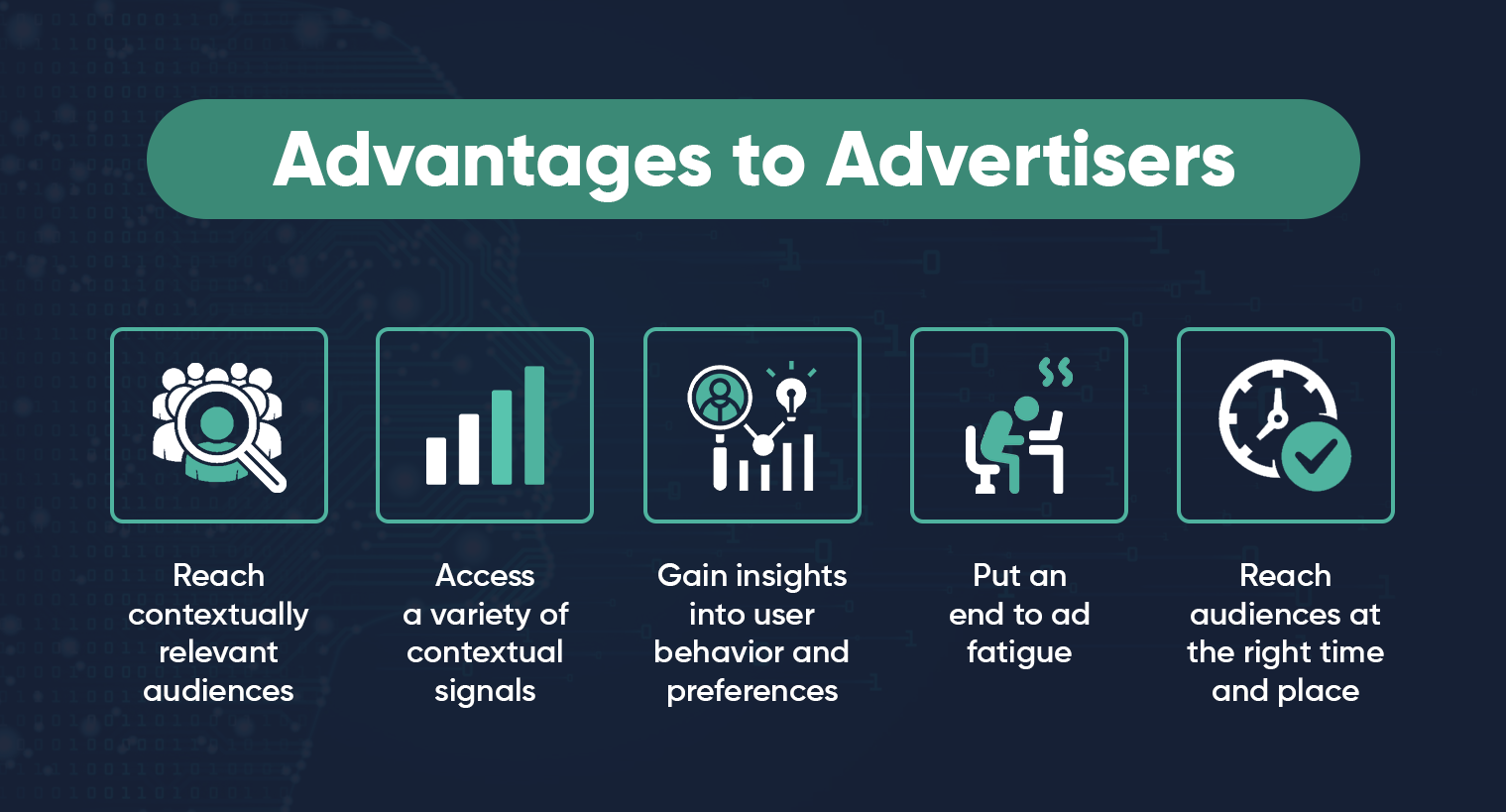
1. This tool will enable advertisers to identify contextually relevant audiences without relying on third-party cookies.
2. The AI-powered contextual platform, Mirrors, will give access to a wide range of contextual signals that can be used to transform brands’ ad targeting strategies.
3. Mirrors, powered by Generative AI, allow advertisers to gain insights into user behavior and preferences, leading to more precise targeting and a better user experience.
4. Generative AI can also solve the problem of users getting tired of seeing the same ad too many times (ad fatigue) and being shown too many ads (frequency capping), which can make them less likely to engage with the ads.
5. By creating unique data sets and identifying new audience segments, advertisers can ensure that their ads are reaching the right users at the right time, without overwhelming them with too many ads.
Final Words
The integration of Generative AI into Silverpush’s contextual AI stack marks a significant advancement in the field of digital advertising. With this technology, advertisers can surpass the restrictions of traditional targeting methods and provide users with more personalized, relevant, and effective ad experiences. But, there’s more to it than you think. Stay tuned for our next blog on Gen AI, where we dive deeper into the potential of this groundbreaking technology and reveal some major possibilities for advertisers.











